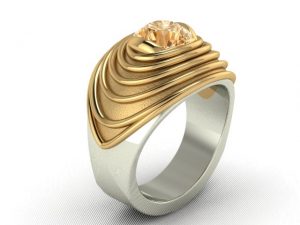Learning CAD: Is bench experience really necessary?
by carly_midgley | October 31, 2017 12:48 pm
By Shele Letwin
 [1]
[1]Bench experience is a widely debated topic, especially when it comes to using CAD. Should CAD designers have experience at the bench? If not, does this mean some important fabrication details may be overlooked? While some suggest this is the case, there’s value in CAD training—bench experience or not.
After 17 years’ experience working with CAD and training others in design software (some with bench experience, some without), I can confirm a working bench knowledge—as limited as it may be—does make CAD easier. Ultimately, who am I to stifle anyone’s creativity? If somebody wants to try CAD, I’ll help them.
It’s rare to find one person who can sell a design, create it in CAD, prep the resin or wax for casting, hand assemble the elements, set the gemstones, and give the piece a final polish. As with other industries, most people specialize.
Who is best?
Jewellers often ask me, “Who is the best person to train for CAD?” For many years, I responded with a bench jeweller or someone who has a creative itch and isn’t afraid of learning a computer program. Today, my answer would be: Your setter, bench jeweller, or a creative person on your team.
However, of the many people I’ve trained over the years, only five per cent of them were setters and maybe 20 to 25 per cent were bench jewellers.
Setters are one of the last craftsmen to work on a piece if there are gems to be set. If a setter is working on a poorly-built model, you will hear about it. Often, setters get paid by the stone, and if it takes more time to set a stone than usual, they will have lost money during this process.
Many bench jewellers enjoy what they do. Whether it is watching the solder flow to connect two pieces of precious metal together or taking a solid block of wax and carving away the unwanted bits, designs comes to life in their hands. When I’d pitch CAD to bench jewellers, many would tell me they were far too busy, but would ask me to train their partners or children.
Hitting your stride
 [2]
[2]I have trained many wives, and many sons and daughters of bench jewellers. For instance, take Toronto’s Joe Tarabay and his son, John. Joe is a setter and was training John to be a setter. However, after I spoke with John, it was clear he had his mind made up and wanted to learn CAD. He was even shopping around for a good software program. I had a gut feeling he wasn’t passionate about setting. He took a primary four-day class with me, which is designed to equip students with design basics on current styles. I always encouraged my students to continue their studies with more classes, and I’m glad he kept at it. Today, John has a successful CAD business in Toronto, 3D Tech Designs, and his mom, Rima, helps out, too.
Tom Sutton, of Winnipeg’s Sutton Jewellers, gave me a big bear hug after I taught his son, James, CAD. Tom had tried to help James find his way into the family business, but hadn’t had any luck striking the right chord. That is, until Tom saw the spark in James’ eyes as he discovered CAD. James had never lit up on the bench the way he did with CAD, and Tom was thrilled to see his son find his stride.
 [3]
[3]
An example of someone with no bench experience finding a way to CAD is Gea Phagoo. Gea and Victor Phagoo are the owners of Red Deer Goldsmiths in Red Deer, Alta.
Gea had been bored with bookkeeping and other daily administrative tasks, so she convinced Victor, her husband, to let her learn CAD instead of buying a new car that year. In the last 12 years, Gea, along with her son, Curtis, who has been CAD-trained, too, have managed to build some pretty interesting, complicated models. CAD has allowed them to put their creative minds to work and add to the family business. It’s been a win-win situation for all, and I’m so thankful I returned her phone call!
Yes, one could argue, John and James had bench experience, but Gea and Rima did not. Hours spent at the bench clearly do not always equate to success in CAD. Sometimes, success comes with having the right tools, the drive to learn, and a passion to create.
Opening doors
 [4]
[4]Education, be it in the classroom or an extension of a curiosity, should be ongoing. I was listening to a talk show radio program the other day, and the host said she paid for both her daughters to go to Ivy League schools. The host, Dr. Christiane Northrup, was encouraging the caller to tell her daughter to learn a trade because college and university can leave graduates with crushing debt after four to seven years. The host’s daughter has a successful online business which had nothing to do with the art history major she completed at college.
My niece was once contemplating her decision going into health sciences when she saw me buy three pairs of expensive designer shoes on a shopping trip. Knowing she would be locked into a government job for the rest of her life, making a limited amount of money, I said, “I can still teach you CAD. It is not too late.”
At the end of the day, learning a new skill can create new opportunities for you and your business.
Trying never hurts
 [5]
[5]
Remember how hard it was to ride a bicycle or learn to play a musical instrument at first? Odds are you weren’t an expert at the beginning. Success takes time and practice. Learning CAD is no different.
Yes, anyone can become a skilled CAD designer who is eager to learn. And yes, a little bench knowledge is good, but it’s not vital. This is a team sport, after all, and you’ll be working with other players with their own special sets of skills.
I truly believe if you will travel in bad weather or long distances or give up a new car, then you have the drive and determination to master CAD. Addy Hung, a very talented bench jeweller, owner of Toronto’s Standard Addy Jewellers, used to say, “magic” whenever I was showing him a new strategy or technique. Indeed, CAD is magical.
So, you still want to try CAD? I say go for it, and surround yourself with a good team because it takes many hands to create a beautiful piece of jewellery.
Shele Letwin is a graduate of the jewellery arts program at Toronto’s George Brown College, an award-winning designer, and a CAD/CAM instructor. She has been a regular guest speaker at trade shows in both Canada and the United States. Her online classes for Matrix 3D can be found www.jewelrydesignonline.com. Letwin can be reached via e-mail at design@shelesjewelrydesignfactory.com.
- [Image]: https://www.jewellerybusiness.com/wp-content/uploads/2017/10/bigstock-144777680.jpg
- [Image]: https://www.jewellerybusiness.com/wp-content/uploads/2017/10/david-1.8ct.jpg
- [Image]: https://www.jewellerybusiness.com/wp-content/uploads/2017/10/Shelly-moore.jpg
- [Image]: https://www.jewellerybusiness.com/wp-content/uploads/2017/10/gear2.jpg
- [Image]: https://www.jewellerybusiness.com/wp-content/uploads/2017/10/gear.jpg
Source URL: https://www.jewellerybusiness.com/features/learning-cad-bench-experience-really-necessary/